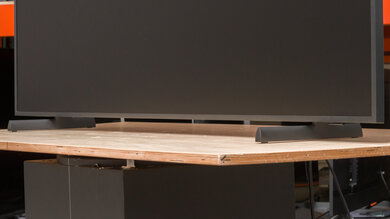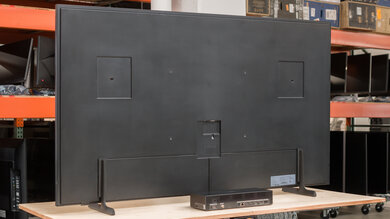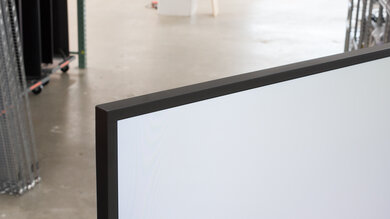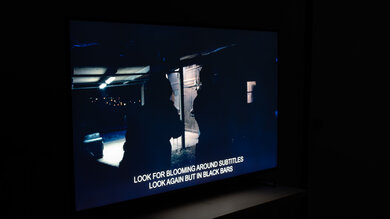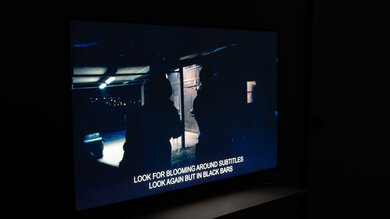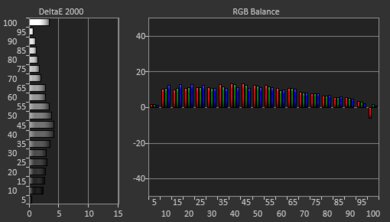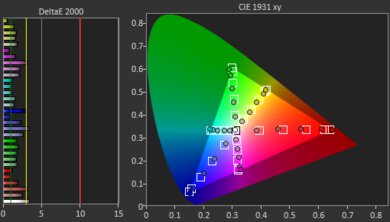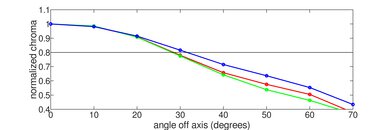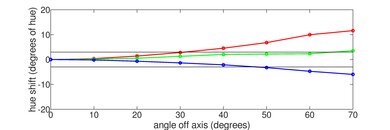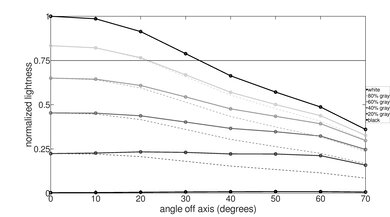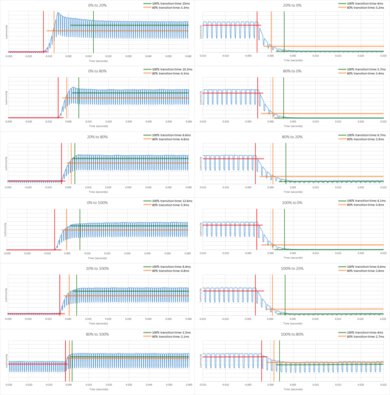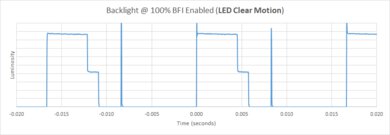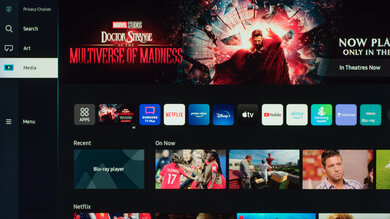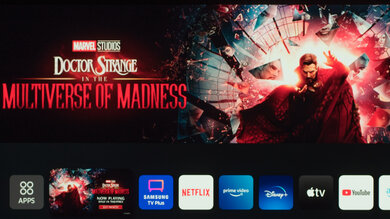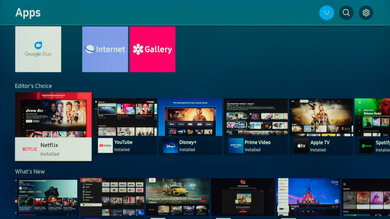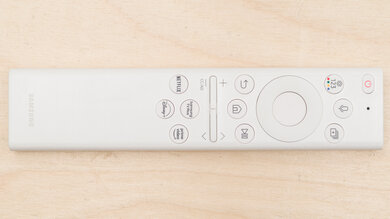The Samsung The Frame 2022 QLED is a unique TV released in 2022 as part of Samsung's Lifestyle TV lineup. It has a unique design that's meant to look like a piece of art mounted on the wall, and it displays pieces of art when you're not watching TV. It comes with a Slim-Fit Wall Mount and normal feet if you don't want to wall-mount it, and there are multiple compatible stands sold separately, including an easel-style floor stand. It has black bezels by default, but you can also purchase bezel covers separately if you want to put a different color or finish. As far as the TV aspect of it, it's a lower mid-range panel with Quantum Dot technology to produce a wider range of colors than traditional LED-backlit TVs, but it doesn't have local dimming or Mini LED backlighting like Samsung's other high-end TVs.
Our Verdict
The Samsung The Frame is a good TV overall. It's good for watching TV shows and sports in bright rooms thanks to its high peak brightness and impressive reflection handling, and it upscales lower-resolution content well. It's also good for gaming because it has HDMI 2.1 bandwidth, variable refresh rate (VRR) support, and low input lag for a responsive feel. It performs well in dark rooms thanks to its high native contrast ratio, but it lacks a local dimming feature to further improve the contrast and make highlights pop in HDR.
- Fantastic native contrast ratio.
- High SDR peak brightness fights glare.
- Matte screen finish has impressive reflection handling.
- Narrow viewing angle.
- Some noticeable uniformity issues.
The Samsung The Frame is good for watching TV shows in well-lit rooms. It has great peak brightness, and the matte screen finish has impressive reflection handling, so glare isn't an issue even in a bright room. The built-in Tizen smart platform makes it easy to stream your favorite shows, and it upscales and sharpens low-resolution shows decently. Unfortunately, it's not a good choice for a wide seating arrangement or if you like to move around with the TV on, as the image degrades rapidly when viewed from the side.
- Decent upscaling.
- High SDR peak brightness fights glare.
- Matte screen finish has impressive reflection handling.
- Narrow viewing angle.
- Some noticeable uniformity issues.
The Samsung The Frame is good for watching sports in a bright room. Glare isn't an issue thanks to its great SDR peak brightness and impressive reflection handling. Fast-moving content like players look great, thanks to the excellent response time, so there's minimal motion blur. Sadly, it has a narrow viewing angle, so it's not a good choice for watching the big game with a large group of friends, as only those sitting directly in front of the TV will see a clear image.
- Decent upscaling.
- High SDR peak brightness fights glare.
- Matte screen finish has impressive reflection handling.
- Quick response time for smooth motion.
- Narrow viewing angle.
- Some noticeable uniformity issues.
The Samsung The Frame is very good for gaming. It has a bunch of gaming features like VRR support to reduce screen tearing. It has HDMI 2.1 bandwidth on one port, which is great for playing high-frame-rate games, but there's only one, so if you have both the PS5 and an Xbox Series X, you can't take full advantage of both. It also has low input lag for a responsive feel, and motion looks smooth thanks to the quick response time. It's good for dark room gaming as it has a high native contrast ratio, but it lacks a local dimming feature to further deepen any blacks.
- Fantastic native contrast ratio.
- Quick response time for smooth motion.
- HDMI 2.1 bandwidth on one port.
- Supports FreeSync, G-SYNC, and HDMI Forum VRR.
- No local dimming feature.
The Samsung The Frame delivers a good movie-watching experience in a dark room. It has a high native contrast ratio, so blacks are deep and uniform in shadow details and darker scenes. It lacks a local dimming feature, so when bright lights are on the screen, shadows are raised and look washed out. It has decent peak brightness, though, so bright scenes stand out and look impressive, and it has a wide color gamut, so HDR looks vivid and lifelike.
- Fantastic native contrast ratio.
- Automatically removes 24p judder.
- Wide color gamut.
- No local dimming feature.
- Some cloudiness in dark scenes.
- Doesn't get bright enough to make highlights pop.
The Samsung The Frame is very good for HDR gaming. It delivers a very good gaming experience in general, thanks to its quick response time and low input lag. It has a good selection of gaming features, including HDMI 2.1 bandwidth on one port, so you can take full advantage of the PS5 or an Xbox Series S|X, and it supports VRR to reduce tearing. HDR looks good overall, as bright scenes look good, but since it lacks a local dimming feature, bright highlights in dimmer scenes don't stand out. It has wide color gamut, so HDR games look vivid and incredibly lifelike.
- Quick response time for smooth motion.
- HDMI 2.1 bandwidth on one port.
- Supports FreeSync, G-SYNC, and HDMI Forum VRR.
- Wide color gamut.
- No local dimming feature.
- Some cloudiness in dark scenes.
- Doesn't get bright enough to make highlights pop.
The Samsung The Frame is an excellent TV to use as a PC monitor. Your on-screen actions feel smooth and responsive thanks to the quick response time and low input lag, with little delay between your mouse movements and the action on-screen. Chroma 4:4:4 and RGB are displayed properly with 4k signals, which is essential for clear text in PC Mode. It also looks good in a bright room thanks to its high peak brightness and matte anti-reflective coating. Sadly, it has a narrow viewing angle, so the edges of the screen are washed out if you sit too close.
- High SDR peak brightness fights glare.
- Matte screen finish has impressive reflection handling.
- Quick response time for smooth motion.
- Narrow viewing angle.
- Some noticeable uniformity issues.
Changelog
- Updated Jul 26, 2024: Added additional information to the Accelerated Longevity Test from the findings on our edge-lit TV investigation.
- Updated Jun 11, 2024: Unfortunately, this TV died as part of an in-depth investigation into edge-lit TVs. It has been removed from the Accelerated Longevity Test.
- Updated May 09, 2024: Mentioned the newly-reviewed Samsung The Frame 2024 QLED in the HDR Brightness In Game Mode section of this review.
- Updated May 02, 2024: We uploaded the latest brightness measurements and uniformity photos for the Accelerated Longevity Test.
Check Price
Differences Between Sizes And Variants
We bought and tested the 65-inch Samsung The Frame 2022, and the results are valid for the 55-inch, 75-inch, and 85-inch models. The 43-inch and 50-inch models deliver similar picture quality, but they have a 60Hz refresh rate and don't support VRR, so they're worse for gaming. The 32-inch model has a lower 1080p resolution, and it's completely different from the other sizes. The last four letters of the model code (in this case, FXZA) vary between regions and even between retailers, but these variants offer the same performance.
The Samsung The Frame comes with black bezels by default, but you can buy different colored bezels that you put on top of the regular ones. Not all sizes are available in the same colors, which you can see below.
| Size | US Model | Short Model Code | Resolution | Refresh Rate | Variable Refresh Rate | Frame Colors |
|---|---|---|---|---|---|---|
| 32" | QN32LS03BBFXZA | QN32LS03BB | 1080p | 60Hz | No | Lemon |
| 43" | QN43LS03BAFXZA | QN43LS03BA | 4k | 60Hz | No | Brown, Teak, White |
| 50" | QN50LS03BAFXZA | QN50LS03BA | 4k | 60Hz | No | Brown, Teak, White |
| 55" | QN55LS03BAFXZA | QN55LS03BA | 4k | 120Hz | Yes | Brown, Teak, White, Red |
| 65" | QN65LS03BAFXZA | QN65LS03BA | 4k | 120Hz | Yes | Brown, Teak, White, Red |
| 75" | QN75LS03BAFXZA | QN75LS03BA | 4k | 120Hz | Yes | Brown, Teak, White |
| 85" | QN85LS03BAFXZA | QN85LS03BA | 4k | 120Hz | Yes | Brown, White, Beige |
Our unit was manufactured in March 2022; you can see the label here.
Popular TV Comparisons
The Samsung The Frame is a good overall TV that's unique because it's designed to sit as part of your décor by displaying artwork. The matte finish gives it a different look than the Samsung The Frame 2021, and you won't get distracting mirror-like reflections. In terms of its overall picture quality, there are better TVs that you can get for cheaper, but if you're set on getting this TV to double as a piece of art, it's better than past Frame Series models.
See our recommendations for the best 4k TVs, the best smart TVs, and the best Samsung TVs.
The Samsung The Frame 2022 is a newer version of the Samsung The Frame 2021. Both TVs are very similar overall, and the main difference is that the 2022 model has a different screen coating. The 2022 version has a matte finish, while the 2021 version has a semi-glossy finish. The matte finish reduces the intensity of mirror-like reflections and makes the screen look more like a realistic piece of art. The 2022 TV also has better out-of-the-box accuracy, but other than that, both TVs are very similar.
The Samsung The Frame 2024 and The Samsung The Frame 2022 are similar, but the 2024 version is slightly better. The 2024 model gets brighter in HDR, so highlights stand out more in HDR content than on the 2022 model. The 2024 model also has better image processing, so low-quality and low-resolution content looks better.
The Samsung The Frame 2020 and the Samsung The Frame 2022 are similar TVs. The main difference is that the 2022 model has a matte screen finish that makes the TV look more like a piece of art, and it has much better reflection handling. It also has better out-of-the-box accuracy, and it has improved gradient handling.
The Samsung QN90A and the Samsung The Frame 2022 are different types of TVs from different lineups. The QN90A is the flagship QLED TV, and while they both use QLED technology, the QN90A uses Mini LED backlighting and has a local dimming feature to provide great black levels and make small highlights pop. The QN90A also gets much brighter in SDR, so it combats glare, but The Frame has a different screen finish with fewer mirror-like reflections. They both have the same gaming features, but the QN90A has four HDMI 2.1 inputs, while The Frame is limited to one.

We buy and test dozens of TVs yearly, taking an objective, data-driven approach to deliver results you can trust. Our testing process is complex, with hundreds of individual tests that take over a week to complete. Most of our tests are done with specially designed test patterns that mimic real content, but we also use the same sources you have at home to ensure our results match the real-world experience. We use two main tools for our testing: a Colorimetry Research CR-100 colorimeter and a CR-250 spectroradiometer.
Test Results

The Samsung The Frame TV is designed to look more like a framed piece of art than a TV. It has thin black bezels, but you can buy covers separately to put on top for a different color and finish. It also comes with the One Connect box to connect all your devices and have one cable going to the TV to keep your setup clean.
After about four months on our long-term test, the Samsung The Frame 2022 QLED developed severe uniformity issues along the bottom edge. We disassembled the TV to better understand the source of the uniformity issues and found that the light guide plate was severely warped, causing light from the edge lighting to seep between the LCD layers and bleed through. The reflector plate is also noticeably warped. Unfortunately, the panel was damaged during this investigation, so this TV has been removed from the test.
As part of our two-year test, which has so far subjected 100 TVs to over 10,000 hours of accelerated testing, we found that edge-lit TVs like this one have significant durability issues. These issues range from warped reflector sheets and cracked light guide plates to completely burnt-out LEDs. You can read the full results of our investigation here.
The wide-set feet do a good job at holding the screen, but it doesn't prevent all wobble. You can raise the feet to a higher position, but placing a thick soundbar in front may block the screen. If you don't want to use the stand, it also comes with Samsung's Slim-Fit Wall Mount to sit flush against a wall.
Footprint of the 65-inch TV: 42.5" x 10.3".
- Height in lower position: 1.45" (to the bezel) and 1.77" (to the screen)
- Height in raised position: 2.44" (to the bezel) and 2.83" (to the screen)
The back of the TV is plain, and there are slots for the Slim-Fit Wall Mount. This TV comes with the One Connect Box, which houses the inputs and is separate from the TV. It helps keep your setup clean because all your devices connect to the box instead of the TV, then connect the cable directly to the TV. There are tracks along the back to help you route the wire for cable management.
The Samsung The Frame TV has excellent build quality. It's all plastic that feels solid, and there aren't any obvious flaws in how it's made. There's only a bit of wobble from front to back, and the back panel flexes slightly, but it's not too noticeable. The biggest issue is that the cable that goes from the One Connect Box to the TV is difficult to plug in and seems flimsy, but this is only a problem if you often need to disconnect the box.
The Samsung The Frame TV has an excellent native contrast ratio. Blacks are deep and uniform in darker scenes. It lacks a local dimming feature, though, so bright highlights increase the brightness of the entire screen, including dark areas, so blacks look more washed out.
This TV doesn't have a local dimming feature, so it can't adjust the backlight of individual zones to brighten up highlights without impacting the rest of the image. But this means that there's no distracting flicker or brightness changes as bright highlights move between zones.
The Samsung The Frame has decent peak brightness in HDR. It's bright enough to make some highlights stand out, but without a local dimming feature, small highlights don't pop against the rest of the image.
These measurements are after calibrating the HDR white point with the following settings:
- HDR Picture Mode: Movie
- Brightness: Max
- Contrast: Max
- Color Tone: Warm2
The Samsung The Frame has okay HDR brightness in Game Mode. It's very similar to outside of Game Mode, and even if it gets slightly brighter, it's hard to tell any difference.
These measurements are after calibrating the HDR white point with the following settings:
- HDR Picture Mode: Game
- Brightness: Max
- Contrast: Max
- Color Tone: Warm2
- HDR Tone Mapping: HDR10+: Basic
If you want a very similar TV but with better HDR Brightness in Game Mode, check out the newer Samsung The Frame 2024 QLED.
The PQ EOTF tracking on this TV isn't very good, and most scenes in HDR are brighter than the content creator intended. Shadow details are raised a bit by the lack of a local dimming feature, and midtones are raised considerably, especially in content mastered at 600 or 1,000 cd/m². Content mastered at 4,000 cd/m² is significantly more accurate but still slightly over-brightened.
The Samsung The Frame has great SDR peak brightness. It gets bright enough to fight glare in a well-lit room, and the brightness is very consistent across different scenes.
These measurements are after calibration with the following settings:
- Picture Mode: Movie
- Brightness: Max
- Color Tone: Warm2
The Samsung The Frame has a very good color gamut. It has excellent coverage of the commonly used DCI-P3 color space, and the tone mapping is good. However, it has limited coverage of the wider Rec. 2020 color space, and some greens and blues are off.
The Samsung The Frame TV has a decent color volume. It displays bright and dark colors well, but it's limited by the incomplete color gamut.
The Samsung The Frame TV has impressive accuracy in SDR before calibration. The white balance and most colors are accurate, but blues and magentas are slightly off. The color temperature is also nearly spot-on with the 6500K target. However, gamma doesn't follow the 2.2 target at all, and most scenes are too bright.
The Samsung The Frame has fantastic accuracy after calibration. It's tricky to calibrate, though, and requires aggressive calibration settings to dial it in.
You can see the full settings used for our calibration here.
The Samsung The Frame TV has a narrow viewing angle. It means that the image fades and appears washed out as you move off to the sides, so if you have it displaying a painting and you walk around, you won't see the same image as if you were right in front.
The Samsung The Frame has impressive reflection handling. The main difference with this TV versus past Frame TVs or even most standard TVs is that it has a matte finish. It helps it absorb more light and reduce the amount of mirror-like reflections. The matte finish also gives the screen a more canvas-like effect, so the artwork on the screen looks more realistic. The main downside to this screen finish compared to glossy TVs is that it introduces some haziness to images, but you have to be sitting close to notice any difference.
The gradient handling on this TV is fantastic. There's no noticeable banding in most similar colors, so any gradients in movies look fantastic.
This TV uses a BGR subpixel layout. It has no noticeable impact on picture quality, but it can cause blurry text in some applications when using the TV as a PC monitor. You can read more about it here. Although the matte finish introduces some haziness, it's hard to tell unless you're sitting really close, and text looks good.
The Samsung The Frame uses pulse width modulation to dim its backlight at all brightness levels. It flickers at 960Hz in the 'Movie' Picture Mode, which is high enough that you won't notice it. However, it drops to 120Hz in other modes, including Game Mode and Art Mode, which can cause image duplications or headaches if you're sensitive to flicker.
The Samsung The Frame TV has an optional backlight strobing feature, commonly known as black frame insertion. It flickers at either 60Hz or 120Hz, but there's bad crosstalk that results in image duplications. Keep in mind that the BFI score is based on the frequency at which it flickers and not the performance.
The Samsung The Frame has a motion interpolation feature to bring lower-frame-rate content up to 120 fps. Like most TVs, it looks fine where there's slow-moving content and characters talking, but there are a ton of artifacts with fast-moving content.
Due to the quick response time, low-frame-rate content appears to stutter because each frame is held on longer. If this bothers you, try enabling the motion interpolation feature.
The Samsung The Frame TV automatically removes 24p judder from any source, which helps with the appearance of motion in movies.
The larger sizes of this TV have a 120Hz panel with variable refresh rate support to reduce screen tearing. It supports all of the common VRR formats, but for G-SYNC to work, the TV needs to be in PC mode. It supports Low Framerate Compensation to ensure a tear-free gaming experience when the frame rate drops below 40 fps. The 32, 43, and 50-inch models are limited to a 60Hz refresh rate and don't support VRR.
The Samsung The Frame TV has low input lag in Game Mode for a responsive gaming experience. You can also enable the motion interpolation feature in Game Mode, and while it increases the input lag, it's still low enough for casual gamers. It has an input lag of 31.7 ms when interpolating 30 fps content up to 60 fps.
The Samsung The Frame TV supports all common resolutions up to 4k @ 120Hz. It also displays clear text with proper chroma 4:4:4 with all its supported resolutions except for 1440p @ 120Hz, as text looks blurry with that signal. The 43 and 50-inch models are limited to a 60Hz refresh rate, and the 32-inch model has a 1080p resolution, so not all signals are supported on these models.
This TV can nearly take full advantage of the Xbox Series S|X, but only on HDMI port 4. On the other ports, you're limited to 4k @ 60Hz. Regardless of which port you use, this TV doesn't support Dolby Vision gaming.
Even if some websites advertise that all four HDMI inputs support HDMI 2.1 bandwidth, the only port to support HDMI 2.1 on the larger sizes is HDMI 4, while the other ports support HDMI 2.0 bandwidth. HDMI 4 supports 40 Gbps of bandwidth, which is enough to display 4k @ 120Hz signals with chroma 4:4:4 in 10-bit HDR. The 32, 43, and 50-inch models don't have HDMI 2.1 bandwidth. Like other Samsung TVs, this TV supports HDR10+ but not Dolby Vision, a common HDR format for streaming services, meaning you'll be limited to HDR10 instead. Lastly, the TV supports ATSC 1.0 and not 3.0, meaning you can't stream over-the-air 4k channels.
You need to connect all inputs to the One Connect box, and there's a slot in the back of the TV to plug in the box. There's also a USB-C port on the back, which you can use to connect a compatible webcam, but you can't use it for media playback.
All variants of the Samsung The Frame TV support eARC on HDMI 3, which allows you to pass high-quality audio to a compatible receiver. It supports Dolby Digital and Dolby Atmos signals. Because it doesn't support DTS or DTS:X signals, you'll need to connect your device to your receiver instead of the TV if the content you're watching uses this audio format.
The Samsung The Frame has an alright frequency response. It gets loud, and dialogue sounds clear at moderate listening levels, but there are more artifacts at the max volume. Also, it doesn't produce much bass, so get a soundbar or dedicated speakers for the best sound possible.
The Samsung The Frame TV has mediocre distortion handling. There isn't too much at lower listening levels, but it increases at the max volume.
The Samsung The Frame TV comes with the same Tizen interface as other Samsung TVs, which is user-friendly and has a full page to display all the apps. Navigating through the menus is smooth, but it takes up to a minute for the TV to open.
You have access to Samsung's Art Store to download artwork, and it comes with over 60 paintings by default, but you need to pay a subscription to download other paintings. You can also upload photos and save them directly to the TV, which has about 7 GB of free storage space.
The Samsung app store has a ton of apps you can download. As mentioned, there's an Art Store to download paintings, but you need to buy a subscription. This TV also supports Google Duo to make video calls with a compatible webcam.
The Samsung The Frame TV comes with the typical Samsung remote, but it's white instead of black. It has shortcut buttons to popular streaming services, and the built-in mic gives you access to Google Assistant, Bixby, and Alexa so you can open apps and change inputs. The remote doesn't need disposable batteries; instead, you can charge it via USB-C or the solar panel on the back.



